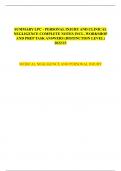SUMMARY LPC - PERSONAL INJURY AND CLINICAL
NEGLIGENCE COMPLETE NOTES INCL. WORKSHOP
AND PREP TASK ANSWERS (DISTINCTION LEVEL)
2022/23
MEDICAL NEGLIGENCE AND PERSONAL INJURY
,
,MODULE: PERSONAL INJURY &
CLINCAL NEGELIGENCE WORKSHOP 1
WORKSHOP 1
VIDEO SCRIPT
Hello and welcome to the first Workshop of Personal Injury and Clinical Negligence.
Before we start, we're going to have a quick talk about the assessment. Your assessment, like
all electives, will be by 3 hour open book exam. There will be 10
multiple choice questions worth 20 marks, and 3 or 4 written questions worth 80 marks. The
written questions will be very familiar because they will seem like
workshop tasks.
There is no mock in the electives, but the format will be very familiar as well because it will
be much like the Dispute Resolution exam.
Let's start Workshop 1. Let's look at the Outcomes. Today we're going to be performing and
focusing on case analysis, in particular for road traffic accidents. We're also going to have a
look at a police accident report to see how we can gain further evidence from that. Then
putting those things together we'll be able to perform a rudimentary risk assessment of the
case. We're also going to have a bit of a talk about conduct and, in particular, in the context of
funding, and at the end we will shortly have a look at some pre-action protocols.
Next, let's have a look at what materials you should have in front of you before we actually
start. So you should have the Workshop 1 guide, which within it includes a prep list and a
prep task. If you haven't read through and done the things on the prep list and if you haven't
done the prep task yet it's worth stopping the video and doing those things before you watch
the rest of it. Also in there are three documents from the Kate Moffat case, which will help
you with the prep task. And there will be two workshop tasks. Task 1 and 2 are written at the
back of the Workshop Guide, but there's also a supplementary category 2 material, i.e. the sort
of thing that you would normally be given by your tutor in class, which you can find on
, ELITE. It's just one task, it's quite large, because it's the Police Accident Report. If you've got
all of those documents then you've got all the paperwork you need, but I would also
recommend, as you would in class, having your Personal Injury and Clinical Negligence
textbook so that you can mark it up, put tabs in and all the things that you like to do to get
ready for an open book exam.
Right, let's get started. Let's look at the prep task. Turning to Page 4 of the Workshop Guide
you can see the prep task set out there, and Part A asks us to look at all the documents that you
have so far to perform a case analysis. You should focus on establishing liability, but we will
have a little bit of a quick chat about quantum as well.
We'll be looking at quantum in great detail further into the course.
So how do we set out a case analysis in personal injury cases? Well, it's not completely
dissimilar from how you did it with Dispute Resolution, except that most of the focus in
Dispute Resolution was about contracts. Where in Dispute Resolution we would have said is
there a contract and what are the key terms, in Personal Injury, because it's a negligence claim,
we're looking for duty.
Then we go on to breach, causation and loss, just like we would with any kind of claim. The
duty here is one of reasonable care to other road users, and it comes from the case of
Nettleship v Weston. In that case, the person was a learner driver, but that doesn't seem to
matter, we've always used this case for all drivers and, indeed, it doesn't matter whether you're
driving a car or a motorbike or any kind of vehicle. It's a duty to take care of other road users.
The breach is much more complicated. We've got lots of detail to think about on breach, but
we can see various different indicators of it from the documents.
Document 1, Kate's letter to us, immediately gives us a ball park idea of the breach in the
second paragraph. She says I was going along at a normal speed and he cut right across me so
that I had to brake sharply, and fell heavily on my hands and arms. That is enough to state
what the breach was, but if we go on to document 3, which is her proof of evidence, she gives
a lot more detail, particularly on the first page of that document. So you should be saying
what the duty is in law and then talking about the breaches as being a matter of fact that you
can find from the various different parts of the evidence.




